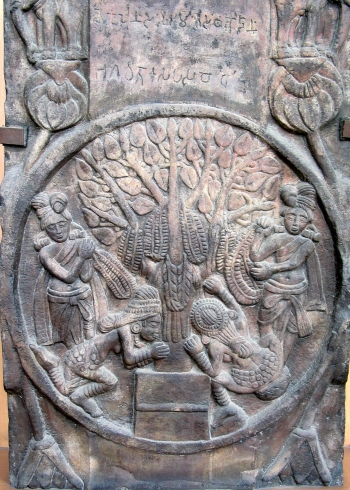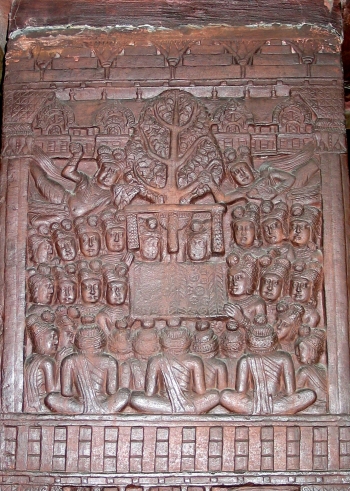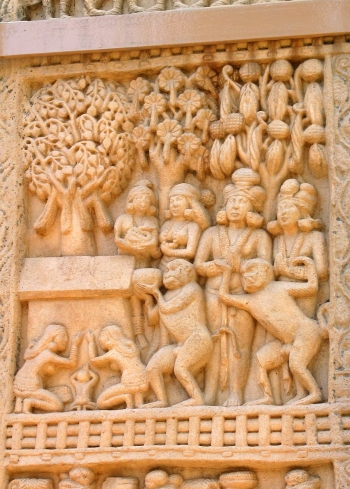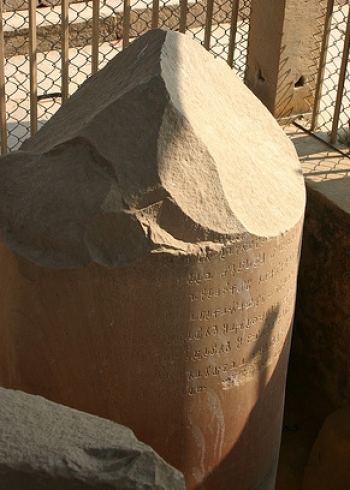One of the mysteries of Buddhist history is the 400-year absence of an anthropomorphic image of the Buddha. Early scholars argued for a period of defacto aniconism, in which artisans decorated Buddhist sacred architecture with a standard stock of Indian religious imagery such as sacred trees, wheels, and stupas. Challenges to this orthodoxy have been rather weak and defacto aniconism remains the dominant view. But the way we think of aniconism, and specifically how we think of aniconic Buddhist art, has shifted considerably.
Perhaps the most important idea to emerge in the last twenty years is the interwoven evolution of text and imagery. Swedish scholar Klemens Karlsson raises the possibility that while the story, the oral-textual tradition, may have influenced the creation of images, the reverse process may also have occurred: images may have influenced the creation of stories.
The wheel, for example, may have influenced the story of the First Sermon. Karlsson notes that canonical sources for the First Sermon vary, and that the wheel metaphor is strongest in later layers of the canon. He notes also the earliest Chinese translations do not include the First Sermon, and that what is left of the inscription on the pillar erected by Emperor Asoka 200 years after the Buddha’s death (in the park where the Buddha is thought to have given this initial teaching) does not contain any reference to the First Sermon. The nativity image is even more clearly evidence of ancient symbols influencing the telling of Buddhist stories. Tree goddesses were typically depicted standing next to trees, one hand grasping a branch, which is exactly how the Buddha’s mother, Queen Maya, is depicted birthing her son (Karlsson, 2006).
Karlsson’s implied question is, “How should we read this art? “ This gets right to the heart of the puzzle of aniconism as it has been argued for the past century. Should the absence of an anthropomorphic Buddha be seen as an absence, as visual expression somehow lacking, or not yet fully developed? If so, it seems we end up, as Susan Huntington observed, judging the work for what it is not, instead of what it is.
Bernard Faure (1998), Stanford professor of Religious Studies, suggests that aniconism is not a lack of symbols, “but rather an excess.” Consider the signs deployed to represent the Buddha – a tree, a stupa, a wheel, footprints, a throne. How much more lively and varied this representation than an anthropomorphic Buddha, how much more layered the meaning, where a tree could be a sacred form of life, the tree of Bodhgaya, a symbol of enlightenment, a symbol of the Buddha, or all four together. Perhaps it is time to think again about this period of Buddhist art and consider replacing aniconism with something more suitably descriptive. Hypericonism may be more accurate and suggests the opposite of lack, emptiness, or negation.
The question of why hypericonism happened when and where it did will likely never be answered. All we are left with are examples of the art, a Rorschach-like test, the answers to which often reveal more about the observer than the observed. The Buddha himself was not fond of those who wanted a reason for everything and so might sympathize with Foucher, Coomaraswamy and Karlsson, who seem to agree that there is no easily discernible reason for this type of art.
Others can’t seem to give up the idea that we can explain it. Linrothe (1993), for example, argues that Indian artisans of the period used sacred symbols as a way to “visually differentiate the Buddha from all other sentient beings.” It was, he says, “the solution to an artistic problem, not a theological one.” David Snellgrove argued much the same in 1978, that the roots of aniconism can be found “in the philosophically radical doctrine concerning [the Buddha’s] true Nirvana essence, inconceivable in visual form and human shape.” Y. Krishan (1996) sees pre-Buddhist Vedic traditions of a formless and invisible supreme being expressed in the absence of the Buddha, what Coomaraswamy (1924) called Brahamical art “adapted to Buddhist requirements.”
These ideas may be right, they may all be right (as artisans in different locations may have operated under even contradictory assumptions), but for all their appeal they are speculative. Until we find textual evidence from an artist, or those who worked with artists, we will never know with any certainty why artisans employed these symbols. Perhaps we would be better served, as investigators of the past, to look in the spirit of Kanako Tanaka, who urges us to “see things in an artistic or aesthetic way… to liberate ourselves from the bondage of philosophical knowledge ….” (1991, p. 61).
Looking thus, we may notice the voluptuous carvings of the female nature spirits at Sanchi and see, as Charles Lachman (2005) does, “that [early] Buddhist ritual environments could accommodate the pleasures of the visual.” There was as yet no distinction between the sacred and sensuous. Sanchi, Bharhut, and Amaravati had not yet been entirely sanctified.
It was, Coomaraswamy saw in 1924, an entirely pagan style, “an art about Buddhism, rather than Buddhist art.”
References
Coomaraswamy, AK. 1924 Buddhist Primitives. In The Dance of Shiva. 1985 ed. New York: Dover. 46-55.
Faure, B. 1998 The Buddhist Icon and the Modern Gaze. Critical Inquiry. 24 (3) 768-813.
Karlsson, K. 2006 The Formation of Early Buddhist Visual Culture. Material Religion. 2 (1) 68-95.
Krishan, Y. 1996. The Buddha image: its origin and development. New Delhi, Munshiram Manoharlal Publishers.
Lachman, C. 2005 Art. In Critical Terms for the Study of Buddhism. Donald S. Lopez Jr. ed. Chicago: University Of Chicago Press. 37-55.
Linrothe, R. 1993 Inquiries into the Origin of the Buddha Image: A Review. East and West. 43 (1-4) 1-16.
Snellgrove, D. 1978 The Image of the Buddha. New Delhi: Vikas Publishing House. Cited in Tanaka, K. 1997. Absence of the Buddha image in early Buddhist art: towards its significance in comparative religion. New Delhi, D.K. Printworld, p. 55.
Tanaka, K. 1997. Absence of the Buddha image in early Buddhist art: towards its significance in comparative religion. New Delhi, D.K. Printworld.
Back to In My Image series homepage
Back to In My Image series homepage


















